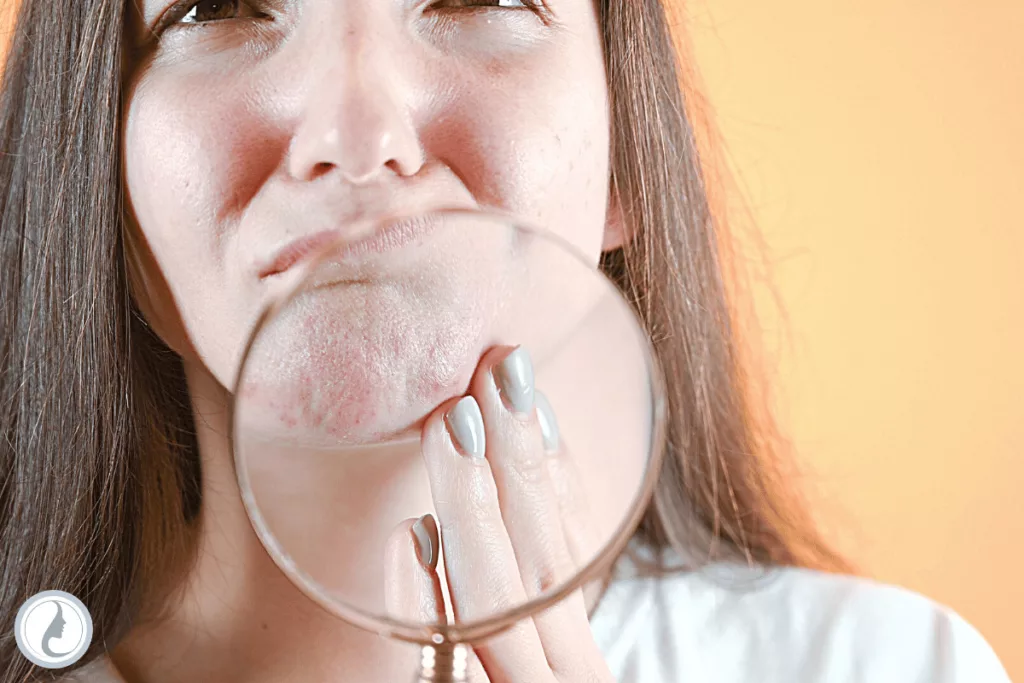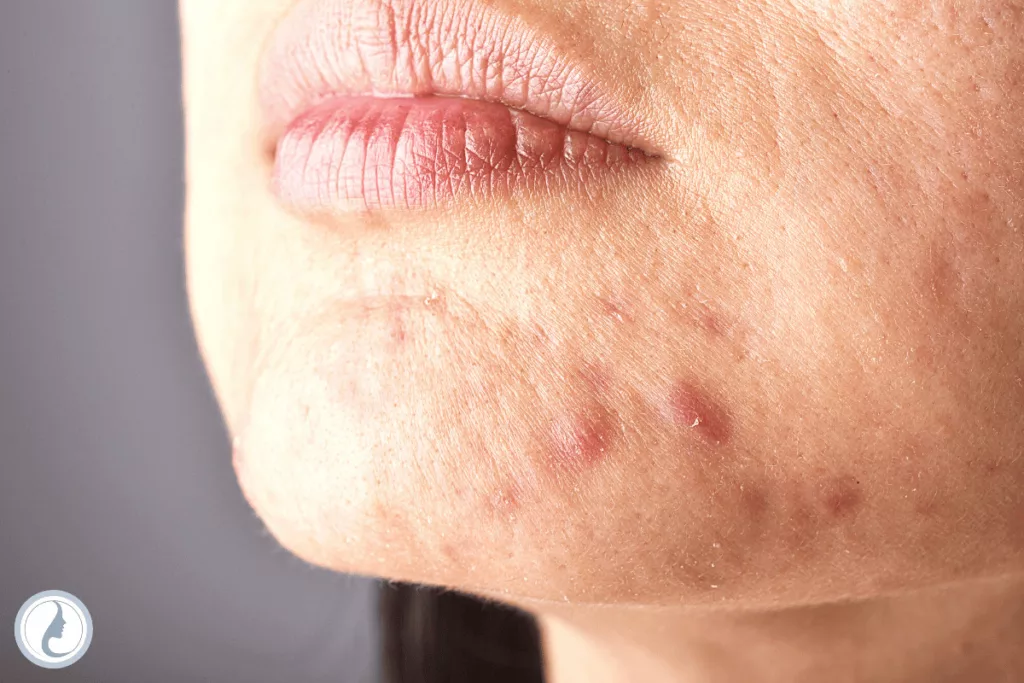Dealing with breakouts after microneedling can be an unexpected and frustrating challenge, leaving you questioning the benefits of this popular skincare treatment. There are risks associated with many beauty routines, and a microneedling treatment is no different. At some point, almost everyone who has undergone microneedling may experience this issue, which can range from mild redness and irritation to more severe acne-like eruptions. But fear not, because we are here to provide you with expert guidance on why some irritation may be good and how to treat breakouts after microneedling effectively.
Are Breakouts Normal After Microneedling?
It’s important to note that experiencing breakouts after microneedling is not uncommon, and in most cases, they are temporary. Interestingly, breakouts after microneedling can sometimes be viewed as a positive sign that the treatment is working effectively.
This phenomenon is believed to result from the skin expelling toxins and impurities from deeper layers and a form of skin irritation caused by the procedure’s skin stimulation. While this might be concerning, it’s a common side effect that typically resolves itself within a few days to a week, depending on the extent of the treatment.
Tips on How To Treat Breakouts After Microneedling
Managing post-microneedling breakouts involves keeping your skin clean, gentle hydration, avoiding makeup and sun exposure, and consulting with your dermatologist when necessary. By following these tips, you can minimize the risk of breakouts and enjoy the full benefits of microneedling for healthy, glowing skin.
Cleansing
Keeping your skin clean before and after microneedling is essential to prevent breakouts. Wash your face with a gentle cleanser twice a day to remove impurities and excess oil that can clog your pores. Avoid using harsh scrubs or exfoliants, as they can irritate your skin and make breakouts worse.
Resist the urge to pick or touch your skin after microneedling, as this can introduce bacteria and cause breakouts or even infections. Let your skin heal naturally and avoid using any harsh products or chemicals that can further irritate your skin.
Related Article: When To Wash Face After Microneedling
Hydrate & Moisturize
After microneedling, your skin needs extra hydration to promote healing and prevent dryness. However, it’s important to choose a gentle moisturizer that won’t clog your pores and cause breakouts.
Opt for products specifically formulated for sensitive or post-procedure skin. Use a soothing and healing serum with ingredients like hyaluronic acid, green tea, or ceramides that can help soothe your skin and reduce redness.
Avoid Makeup and Harsh Products
Give your skin a break from makeup and any skincare products that contain potentially irritating ingredients, such as retinoids or alpha hydroxy acids. It’s recommended to avoid wearing makeup for at least 24 to 48 hours after microneedling to prevent clogging your pores.
Once you notice any active breakouts, cease using skin care products, as their active ingredients could be the root cause or the products may not be acne-safe.
Minimize Sun Exposure
Avoid direct sun exposure and use mineral sunscreen with a minimum SPF of 30 or higher if you need to go outside. UV rays can irritate your skin and make breakouts worse.
Related Article: Sunscreen After Microneedling
Consult Dermatologist
If you experience persistent or severe breakouts after microneedling, it’s important to consult with your dermatologist. They can evaluate your skin and provide personalized recommendations for managing post-microneedling breakouts based on your individual needs.
Why Do Breakouts Occur After Microneedling?

Here are some of the most common causes of breakouts after microneedling.
Post-Treatment Products
Using the wrong choice of beauty products after a microneedling treatment is the most common reason individuals suffer from breakouts. Some skincare products contain harsh ingredients that can irritate the skin, clog pores, and cause breakouts.
For example, ingredients like retinol and vitamin C can be magic for skin healing, but you can’t use those products directly after your procedure. During this time, because your skin will be ultra-sensitive, these generally helpful ingredients can cause damage.
Bacterial Infections
The tiny punctures created during microneedling leave your skin open and vulnerable to bacteria, which can lead to breakouts. Bacteria can also be transferred if the device used during treatment is not properly sterilized or if the skin is not properly cleansed.
To minimize the risk of breakouts, it’s important to choose a qualified and experienced professional to perform the treatment and avoid such risks. Share any medications or health conditions that may increase the risk of breakouts with your provider.
Acne Prone Skin
Another reason for breakouts is that you are already acne-prone, and the procedure has made your cystic acne worse in the short term. When microneedling is performed on skin that has active acne, it can result in the needles carrying and spreading that acne bacteria all over the skin.
The punctures in the skin can also push dirt, oil, and other debris deeper into the skin, leading to clogged pores and breakouts. This is more common in individuals with oily or acne-prone skin.
Skin Sensitivity
Some individuals may have a sensitive skin type that reacts negatively to the microneedling process. In these cases, the body may have an inflammatory response, leading to breakouts.
For this reason, it’s important to protect your skin from the sun’s rays for at least two weeks after microneedling as sun exposure could be a reason for any breakouts that you have. The skin is incredibly delicate during this time, and UV rays will cause sunburn and damage, causing redness, pain, and inflammation.
High-Risk Medications
Certain medications, such as blood thinners and acne medications like Accutane, can increase the risk of breakouts after microneedling.
How Long Do Breakouts Last After Microneedling?

Breakouts tend to resolve themselves within the first few days after treatment, especially when following the right aftercare regime. If you are acne-prone and the treatment results in active lesions, these should generally disappear within 3 or 4 days.
Breakouts related to using ingredients too soon will generally subside quickly if you have stopped using the product. Flare-ups related to sun exposure may last as long as five days, as it is important to keep the skin hydrated and avoid further exposure.
After any breakout, you may see areas of the skin that are slightly swollen, but this swelling will dissipate shortly afterward.
How To Prevent Breakouts After Microneedling?
Preventing breakouts from microneedling begins long before your treatment, and this goes for those with and without acne-prone skin. For two weeks before the treatment, you should do the following:
- Avoid exfoliating products
- Avoid exposure to sun’s rays
- Discontinue topical products like moisturizers and toners
- Avoid Accutane or acne medication
If you have acne-prone skin, your dermatologist may also recommend waiting for it to clear before recommending microneedling. This procedure cannot address active acne lesions and cause further irritation if you have active acne.
Those with delicate skin should speak with the dermatologist first, as this is not a recommended treatment for all skin types. A microneedling treatment on those with rosacea or very sensitive skin can result in further problems.
Post-Treatment Skincare Routine
Generally, the best product to use for the first 24 hours following treatment is hyaluronic acid. This is a fantastic ingredient for maintaining moisture in the skin and prompts the increased growth of collagen and elastin. Additionally, you can use products that contain vitamin E, linseed oil, and kiwi oil, all of which can support the skin’s repair and reduce the likelihood of breakouts.
Related Article: What To Put On Skin After Microneedling
Types of Breakouts After Microneedling
There are two types of breakout you could see after microneedling treatment: the first is an acne breakout, and the second is milia. Naturally, those with acne-prone skin are the prime candidates for acne breakouts, although others could suffer from the same issues.
It is important to take swift action if this occurs to reduce the risk of acne scars. Milia is a collection of tiny white bumps that occur just beneath the top layer of skin.
Some soreness in the affected area can also accompany this. This is caused because microneedling briefly upsets the skin’s balance and will usually disappear in a few days.
In this case, milia happens because of dead skin cells trapped under the surface. No treatment is required if you see these whiteheads after microneedling.
Timeline of Breakouts
Acne can flare up at any time during the microneedling recovery process as several factors could cause such a breakout. It is most often seen within a week after the procedure but could occur later if it is triggered by a bad ingredient or exposure to the sun’s rays. A milia breakout will be seen much earlier, as soon as two days after microneedling.
Final Tip
Microneedling is a valuable skincare procedure for addressing aging concerns and even for those struggling with acne-prone skin. While breakouts are not ideal, they are not uncommon and are generally a sign that your treatment is working correctly. Fortunately, by adhering to expert-recommended pre and post-care routines, plus guidance from your dermatologist, you can significantly minimize the risk of experiencing these post-treatment breakouts. These proactive measures empower individuals to reap the full benefits of microneedling with greater confidence.
FAQ
Is it Normal to Breakout After Collagen Induction Therapy?
Breakouts are not common after microneedling (CIT,) but they can be considered normal and are rarely something you should worry about.
Is it Normal to Breakout Two Weeks After Microneedling?
It is not abnormal to break out two weeks post-treatment, yet it is not seen often. This will usually be caused by exposure to harmful ingredients in skincare products or triggered by over-exposure to UV rays.
